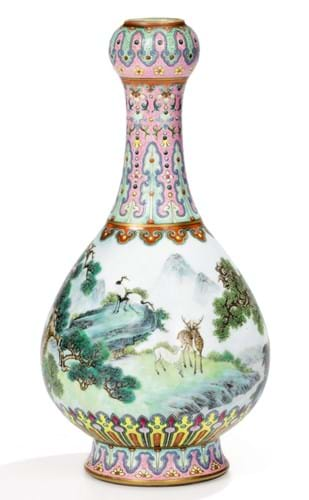
The vendors were unaware of the item’s potential value and it was brought into the auctioneers’ Paris saleroom in a shoe box.
It was identified by Sotheby’s specialist Olivier Valmier as an apparently unique Imperial 18th century ‘yangcai’ famille-rose porcelain vase. It will now be offered at Sotheby’s Paris on June 12 with an estimate of €500,000-700,000 (£430,000-610,000).
The vase, produced by the Jingdezhen workshops for the Qianlong court, was left to the vendor’s grandparents by an uncle. According to a list of contents kept in his Paris apartment at the time of his death in 1947, he also owned other Chinese and Japanese objects including an unusual bronze mirror contained in a carved lacquer box which will also be offered at Sotheby’s.
‘Yangcai’ means ‘foreign colours’ in Chinese and refers to the over-glaze painting with transparent enamels. Objects were usually decorated with Western-style compositions and are often either unique or made in pairs.
The body of the vase at Sotheby’s is decorated with a landscape with deer, cranes and pine trees, all auspicious symbols of health and longevity. The landscape likely derives from one of the Imperial parks with the fallow deer representing happiness and prosperity and the cranes personifying old age.
Only one similar vase in terms of the combination of shape and design is known, although the example in the Guimet Museum in Paris has a slightly different subject matter and border decoration.
The Imperial inventories drawn up in the 18th century twice mention a pair of vases with this design: one pair commissioned in 1765; the other ordered as a birthday gift in 1769.






